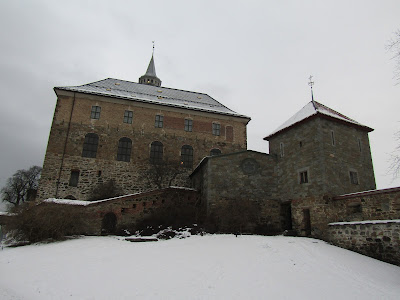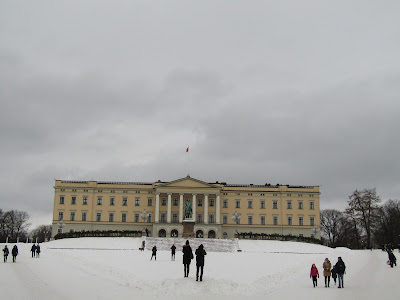Inspired into Action?
This week Oslo has been hosting the International Documentary Film Festival with the theme Human Rights & Wrongs. All week there have been a number of different film screenings, debates, talks, and art events. Unfortunately, I had a final exam so I missed a lot. On the bright side, there is still a lot going on this weekend, including tomorrow on the final day of the festival.
Film festival program.
I've never been to a film festival before, so it was really a nice experience! Not to mention the tickets for students were very reasonable and the venue (Vega Scene) was great. I'm hoping tomorrow to go to a couple of the lectures as well. I highly recommend going to the film fest or checking out some near you; documentaries can be really interesting!
There really was a great variety of films with many different themes. See here for full event program. Today, I watched two documentaries, Anote's Ark and Grit.
First one in the theater; excited to see Anoke's Ark.
Anote's Ark was about former president of Kiribati, Anote Tong's journey of trying to fight to ensure his people will be taken care in the face of catastrophe caused by climate change. What catastrophe exactly am I talking about?
Program description for Anote's Ark.
Kiribati (pronounced Kiri-bas) is a series of islands located in a unique part of the Pacific Ocean, situated right along the equator, and in both the Northern and Southern Hemispheres. Historically, the region never had any storms, but with changing weather patterns has been pummeled by hurricanes, and tropical storms which have flooded villages, destroyed homes, ruined fresh water sources and agricultural lands. Even without the storms, the islands face a far worse fate. By the end of the century, the nation will be completely underwater due to rising sea levels. Where will the people go? Will they be able to preserve their culture and traditions? It's not a matter of if the islands will be swallowed by the sea, it's when, and which other nations will follow thereafter.
The story followed a Kiribati family making the move to New Zealand to start a new life, and also showed the president's journey to protect his nation's future. During the Paris talks of 2015, President Tong was instrumental in making sure large countries like the US would pay to help islands adapt. It wasn't a matter of 1.5 C or 2 C degrees, because climate change was already coming to conquer Kiribati. The president bought some land in New Zealand for his people to move to when they become climate refugees. Yet, there are still many questions. What kind of life would the people have in New Zealand? Do they need visas? What jobs could they do there?
Inside Vega Scene theater.
Refugees are forced to flee their homelands because they have no other choice. The islanders don't want to move. They don't want to lose their motherland, their lives, their histories. But there is no other option. Kiribati's story is not the only one that will end this way. Climate change, global warming, call it what you like. It is happening. It is everywhere. Maybe your home won't be swallowed by the seas, but the heat will grow, the rains will pound, or you will see other adverse effects.
The saddest part of the story is that the innocent people and countries, those who contribute least, pay the most. Kiribati is just the first of many places which will meet the same fate from climate change. We must all work to do our best by consuming less, and ensuring opportunities for all to have a bright green future. Planet over profit, always.
Anoke's Ark was a sad film, but an inspiring one too. It's easy to feel hopeless from all of the negativity, but sometimes you need to use it to channel change, and propel yourself into action. The movie was also quite touching, because before the film began there was a clip Anoke recorded specifically for us at the festival, to motivate, especially the younger generation to take charge of the future, and work to set things right. The film also won the honorable mention for the festival's Human Rights, Human Wrongs Film Award. Watch the trailer and learn more here.
Screen tonight after the showing of Grit.
The other film I saw today was Grit, which chronicled a young girl whose family's village was wiped out from the Sidoarjo mud flows in Indonesia. As the girl goes through middle and high school, she starts to be an activist in her community, and decides she wants to become a lawyer to fight for environmental justice. The film highlights the burdens placed on many communities, and the all too common injustice caused by rich companies' environmental negligence.
Description of Grit from the program.
It all started in 2006, when the natural gas company Lapindo, carelessly drilled down too far into the earth, striking a mud pocket. A mud volcano exploded, burying sixteen villages. The mud continues to pour out every day, even though it's been thirteen years since the explosion. Today, the Sidoarjo mud flow continues to rise, despite also continuously draining into the local rivers.
The only thing preventing the mud from reaching more villages are levies, which are being built higher and higher as the mud continues to flow. The levies are just another disaster waiting to happen. Furthermore, there is speculation that the mud and fumes from the volcano are toxic, because people have died from cancer after working there, and there have been massive fish die offs in the rivers. Following the disaster, the government deliberately cut off studies of the mud from the area, so the health dangers remain a mystery, threatening those who are forced to work on the mudflats.
Event posters inside of Vega Scene.
Following the disaster was poverty and problems for the locals, who had to fight for over nine years to ever get any sort of compensation. Justice still isn't served. Lapindo has started to drill again, the mud continues to flow, and corruption continues to buy free passes for powerful companies.
It was my first time hearing about the mud volcano in Indonesia, so I found the film very interesting. However, at the same time I was also very angry about the greed and injustice. Too often those with money take advantage of others; hurting people and the planet in greedy pursuit. Overall, interesting movie, and I hope Indonesian activists will continue to fight to protect their communities. You can check out the trailer and learn more here.
Festival posters inside Vega Scene.
Thank you to the Human film festival for bringing global problems closer to home, teaching me about the injustices, & inspiring me to want to fight to make things right!




















































